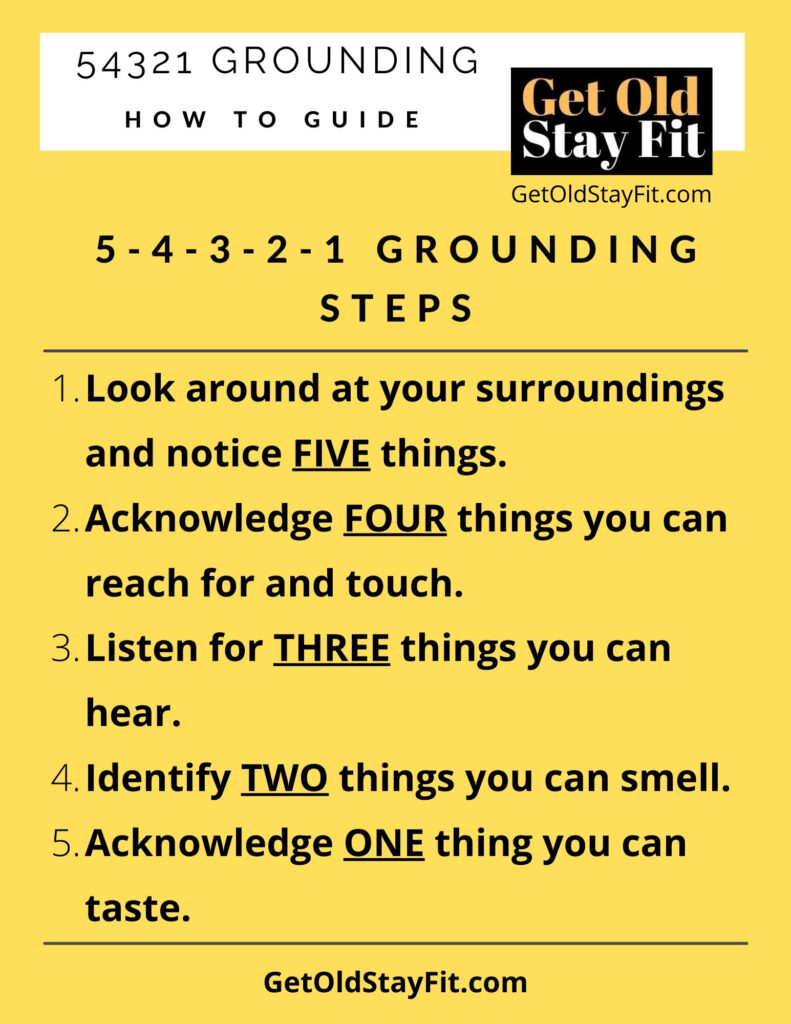There are a few amazing grounding techniques to help relieve sudden anxiety attacks. Many people are not aware of the numerous methods to help calm the mind and body when faced with growing panic, fear, or worry.
One method that has been used with much success has been the 54321 grounding technique for anxiety relief.
The next time you’re feeling stressed, try this grounding technique. Its been successfully used for years to help soothe panic attacks or high-stress moments.
It’s a useful technique for stressful situations, hard times, fighting negative thoughts, and even gaining mental focus.
The 54321 grounding technique can even be a great coping skill for the nerves before and during public speaking when even the calmest person feels anxiety.
Go a step beyond this simple calming technique and add deep breaths and deep breathing exercises for an incredible combination of anxiety relief and stress management.
54321 Grounding Technique
Sometimes you might find yourself, or someone close to you, dealing with feelings of anxiety, intrusive thoughts, flashbacks, or difficult situations in their daily life.
Various anxious thoughts can create an anxiety spiral and drag them down. Like an anchor on a ship, it holds them back from moving forward and accomplishing the things they need to do.
One effective method to calming your mind, soothing strong emotions, and relieving stress is the 54321 grounding technique. This is a simple practice to refocus your thoughts, which can be a quick and effective way to deal with anxiety.

Simply begin by counting down from 5, and work through this practice slowly and methodically. Take your time, and don’t forget to breathe slowly with each inhale and exhale.
5. Look around your surroundings and notice FIVE things you see. Count them off and name the items in your head—chair, window, tree, carpet, fireplace, a smooth stone on the ground.
Take time to recognize each of the five items you see. Acknowledge the detail of each item. It can be large objects or even the smallest detail. Name each item before you move on to the next.
4. Next, acknowledge FOUR things you can actually reach for and touch—keyboard, book, pen, glass.
Again, just like the previous exercise, identify four items. But this time, the items need to be within your reach. Maybe it’s the armrest on your chair or a glass of water on your desk.
3. Listen for THREE things you hear. Concentrate on listening to noises and identify where those sounds are coming from. Birds, Airplane, Wind. Pay attention to each sound as you hear it.
You might have trouble hearing three distinct external sounds initially. Stay silent and focus. You will begin to notice the small details of what’s happening around you.
Even the tiniest tick of a clock with become apparent.
2. Identify TWO things you can smell. Take a short walk around if needed, find two distinct smells, and call them by name: candle, or coffee.
Finally, acknowledge ONE thing you can taste. What is the sensation of this object? Gum, name the taste you are experiencing.
1. Finally, acknowledge ONE thing you can taste. What is the sensation of this object? Gum, name the taste you are experiencing.
Other Grounding Methods
There are many other tricks you can apply to the 54321 grounding exercise. While it’s recommended you take a deep belly breath to begin the 54321 Grounding Technique, breathing alone can provide a huge relief to stress.
The 54321 Grounding Technique can be used by physicians and counselors as part of psychotherapy treatment. Behavioral health professionals have many methods, but a simple mindfulness exercise such as this one can do wonders to reduce anxiety.
In Cognitive Behavioral Therapy, our thoughts are linked to our well-being. As long as you believe your thoughts can bring you back from anxiety, then you have the tools for self-regulation.
Simple techniques can sometimes be the most effective during the darkest moments.
The 5-5-5 Rule for Anxiety
There’s another simple method for calming the body and mind. The five-five-five rule.
- Breath in for 5 seconds
- Hold your breath in for 5 seconds
- Breath out for 5 seconds
Repeat the cycle for as long as necessary. You might notice your mind slowing down, your thoughts getting less intense, and your body feeling more relaxed.
The 3-3-3 Rule for Anxiety
Yet another coping skill and trick for calming the mind is the three-three-three rule.
- Look around and name three things you can see
- Listen carefully and name three things you can hear
- Finally, move three parts of your body and name them – foot, leg, fingers, etc.
Breathe
Take a breath; you’re finished with the 54321 grounding technique. By taking time to notice your surroundings, you bring your mind into the present moment.
It’s a great method to detach the mind from its troubles. Use this method as a quick way to head off the early warning signs of stress and anxiety.
Now, I can only speak from personal experience, but the combination of the 54321 grounding technique along with breathwork can be great for self-care and reducing anxiety.
Long breaths with deep belly breaths exhaled slowly can reduce heart rate and have a calming sensation. It’s one of my favorite things to practice for general relaxation and overall mental health.
James Nestor
When I read James Nestor’s book titled Breath, I was introduced to the power of breathing. I had no idea we had the power to control our bodies through our breath.
I know it sounds crazy to someone unfamiliar with the concepts. Still, by consciously breathing, we have the ability to lower our heart rate and tap into our parasympathetic systems.
By controlling your breath, you have the ability to influence systems deep within your body.
Additional Resources –
Relaxation Techniques: What You Need to Know – NIH.gov
Relaxation Training for Anxiety – BMC Psychiatry
Effectiveness of Relaxation Techniques – ResearchGate.net
